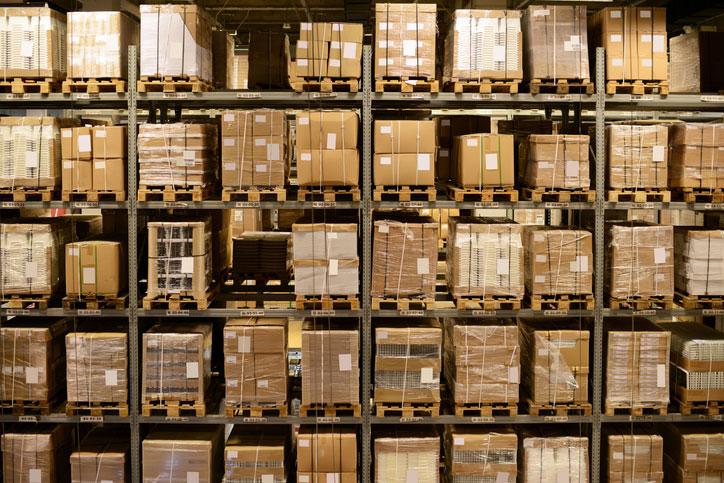Modernizing Your Warehouse: Available Technologies
This is Part 2 of a five-part series for midmarket distributors looking to bring their warehouses into the future. We recommend you start with Part 1.
WAREHOUSE TECHNOLOGIES AND CONSIDERATIONS
Managing inventory and warehouse operations is easy when you are small. Warehouse management becomes more difficult as distributors grow, adding more locations, large facilities, and larger product lines.
Growing distributors and those using entry-level accounting or legacy distribution ERP systems must modernize warehouse operations to remain competitive. This often warrants a replacement of the business system or the acquisition of expensive warehouse management software.
This series of articles provides wholesale distributors with an overview of warehouse management features and technologies. It includes a self-assessment to determine what steps to take next. It also provides WMS strategies and a process for executing WMS implementations to modernize warehouse and distribution center operations.
Let’s take a look at some of the specific technologies available that can help midmarket distributors bring their warehouses into the 21st century and beyond.
WAREHOUSE TECHNOLOGIES
Inventory and warehouse data entry is time-consuming and prone to manual data entry errors. Paper-based inventory receipts, picking, packing, and shipping documents contain information that needs to be captured quickly into the warehouse management and ERP database. Automated data capture and other automation technologies are available in some ERP systems. Other ERP systems require the purchase of advanced warehouse management systems (WMS).
BARCODES AND RFID TAGS
Even the smallest distributors have tethered barcode readers and the ability to print barcodes on reports and labels.
Barcodes come in assorted styles. Systems should support the standard GS1 Global Trade Item Number barcode format. Barcodes work with varied devices including mobile devices, ruggedized tables, and specialized scanners.
RFID tags provide the same automated data capture features as barcodes with zero human intervention. Tags on products or containers pass nearby radio receivers transmitting information such as items and location back to the software. RFID costs are more affordable than ever before with improved accuracy.
Barcoding is affordable and often supported natively in midmarket ERP applications. RFID is more complex to setup initially with a longer-term payback for hands-free automation.
PAPER AND OCR SCANNING
Paper-based data capture still has a place in many warehouses. It is useful to fill procedural gaps that are difficult to automate.
Further, they provide a physical record of transactions and information that back-up digital versions of the data. However, they are not real-time, and they are prone to data entry errors.
OCR Scanning is used in many warehouse environments, especially for scanning information from inbound vendor documents such as bills of lading and packing slips during the receipt of goods process. OCR can save complete documents in a database. With extra setup and mapping – it can extract and store data such as item numbers, quantities, and dates directly in the ERP or WMS system. OCR document capture is compatible with most ERP systems. OCR is affordable and easy to learn with minimal setup or training.
VOICE RECOGNITION
Voice-recognition is another option for automated data capture. Voice directed warehousing (VDW) is newer yet. VDW is more complex to setup but it offers many advantages including hands-free, directed picking and put-away.
It can also be used for most inventory transactions including packing, shipping, and physical inventory cycle counts. VDW is compatible with modern wearable technologies and provides easy access to information chatbots or virtual assistants.
ROBOTICS AND CAROUSELS
Robotics are now more affordable allowing even small distributors to leverage them for inventory movement and other warehouse activities. Storage carousel systems can be expensive, but they save time and reduce picking errors. Items are automatically picked, sorted, and delivered to the operator for additional operations such as packing and shipping.
ERP SOFTWARE
Some ERP systems provide light WMS features such as automated inventory replenishment. Barcode scans automate the put-away, picking, transfer, movement, packing, and shipment transactions from a single scan. Advanced workflows can further automate inventory and warehouse processes. Some systems also support automation of picking and packing during shipment and automatic lot, serial, or bin selection based on preconfigured rules.
ARTIFICIAL INTELLIGENCE (AI/ML)
Artificial Intelligence (AI) and Machine Learning (ML) promise to improve many warehouse management processes including data capture. AI for example can compare manually entered quantities from receipt of goods against the quantity on the originating purchase order to validate that the quantities are the same. Machine learning can determine the oldest available product lot to pick for an order based on expiration dates. It can also be used to determine which shipping carrier to use for a customer order based on rates, lead times, and other factors.
WMS SYSTEMS
Warehouse Management Systems combine multiple automation technologies into a single platform. These technologies include barcoding, RFID, voice, and integration with robotics, carousels, and other warehouse automation technologies.
WMS applications provide many advanced features not common in midmarket ERP applications such as crossdocking, license plating, integration with third party logistics (3PL), load and route optimization, and more.
WMS is an excellent option for distributors with larger distribution centers or companies using ERP systems that do not provide warehouse automation functionality without considerable customization.
WMS applications can be expensive with significant costs for implementation and training making it difficult for smaller distributors to justify the investment.
WHAT ACUMATICA CAN DO FOR YOU
Acumatica Cloud ERP provides the best business management solution for digitally resilient companies. Built for mobile and telework scenarios and easily integrated with the collaboration tools of your choice, Acumatica delivers flexibility, efficiency, and continuity of operations to growing small and midmarket organizations.
MODERN WAREHOUSE MANAGEMENT WITH ACUMATICA DISTRIBUTION EDITION
A modern warehouse is crucial for wholesale distributors to thrive in today’s digital economy. Entry-level business applications and legacy ERP software pose barriers to modernization projects forcing many distributors to invest in costly customizations or complex and expensive warehouse management systems.
Distributors need to understand inventory and warehouse technologies so they can improve and automate business processes. They must understand how to utilize ERP and WMS features effectively for inventory management, order processing, inventory transactions, warehouse automation, and compliance and reporting.
A disciplined strategy is critical to the success of warehouse modernization projects. The strategy establishes a solid foundation, provides research, and defines priorities for the modernization plan. A four-phased execution approach ensures that distributors are prepared for implementations with continuous review and process improvement.
Acumatica Distribution Edition provides a modern platform for wholesalers to modernize warehouse operations with tools to manage projects, support cases, and installations or upgrades. Through leading-edge cloud technology, Acumatica Distribution Edition delivers unparalleled value to small and midmarket distributors. Integrated workflows span the full suite of business management applications with native warehouse management and barcoding features.




